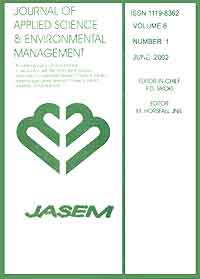
|
Journal of Applied Sciences and Environmental Management
World Bank assisted National Agricultural Research Project (NARP) - University of Port Harcourt
ISSN: 1119-8362
Vol. 11, No. 2, 2007, pp. 129-136
|
 Bioline Code: ja07037
Bioline Code: ja07037
Full paper language: English
Document type: Research Article
Document available free of charge
|
|
|
Journal of Applied Sciences and Environmental Management, Vol. 11, No. 2, 2007, pp. 129-136
| en |
Performance Evaluation Of Biosimulator For Treating Domestic Wastewater Using activated Sludge Treatment System
Imran, Hashmi
Abstract
This research investigation was aimed at demonstrating the performance evaluation of pilot
activated sludge treatment system (biosimulator; model MF-114). An intensive analytical program was followed for
evaluating the performance efficiency of the biosimulator by maintaining the dissolved oxygen (DO) concentration at
4.0 mg/L throughout the study period. Biosimulator performance was evaluated after every 2 hours and analyzed for
pH, DO, COD, ammonia-nitrogen (NH3-N), nitrite-nitrogen (NO2-N) and nitrate-nitrogen (NO3-N). In all ten
experimental replicates were performed and the mean figures are taken for discussion. Although no significant
variation in the pH was observed during the study period but the mean pH values of the samples during the treatment
process gradually increased and it ranged from 6.81-7.52. The removal of COD was found to be in direct relationship
with retention time and the mean COD of the raw wastewater samples ranged from 164-1160 mg/L whereas it got
reduced considerably during the treatment process and the mean removal efficiency was found to be 86%. The COD
and NO2-N removal efficiency was better than NH3-N and NO3-N this is considered to be satisfactory especially with
respect to organic loading and retention time. Similarly, the mean NH3-N values of wastewater after 29 hours of
treatment were found to be fluctuating between 14.52-20.54 mg/L whereas the mean NO3-N level of the raw
wastewater ranged from 0.106-0.279 mg/L. The overall conditions were very much favorable even at high organic
loading and minimum retention time. It is therefore concluded that the system is practically feasible for the treatment
of wastewater containing high content of organic matter.
|
| |
© Copyright 2007 - Journal of Applied Sciences & Environmental Management
|
|
